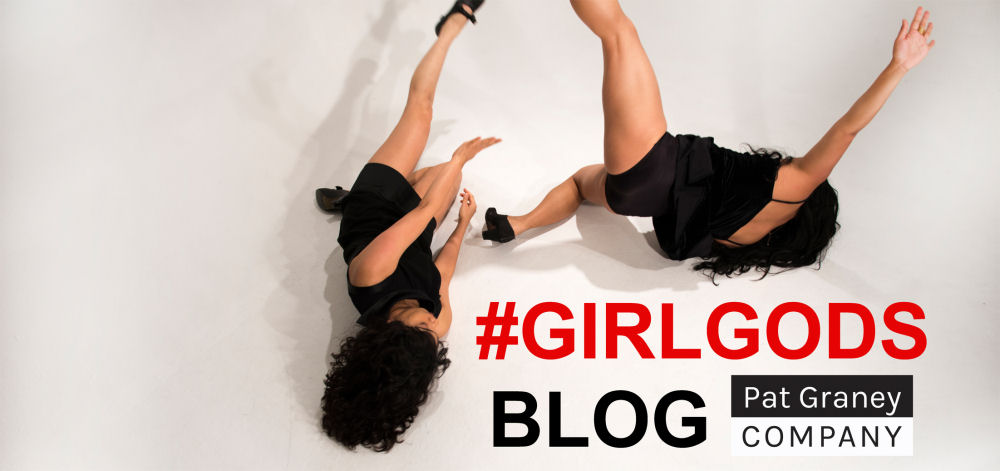#GirlGods Blog No.1 : Quiet Riot: Modern Dance as Embodied Feminism/Women Respond to Elles @ SAM (By Tonya Lockyer)
The following essay offers some historical context on how women choreographers have been, in Tonya Lockyer’s words, “kicking-ass as ambitious, forward-thinking creatives for over a hundred years”.
In contemporary discourses on the body, dance has not received the same critical or philosophical attention as the fields of art, literature and cinema. Yet dance would appear to be a natural starting point. It is one of the few art forms in which feminist theory is actually embodied.
Janet Wolf proposed in her essay Reinstating Corporeality, “Since the body is clearly marginalized in Western culture, it might appear that dance is an inherently subversive activity.” (422) What to make then of the ballet Swan Lake where, given the choice between a real woman or a swan, the hero prince Albrecht chooses the bird? Romantic and classical ballet, rather than celebrate a real corporeality, colluded a weightless, classical ideal of ‘Woman’ as a symbol of spiritual purity. In contrast, Modern Dance, since its inception at the turn of the twentieth century, has predominately been viewed as a breakthrough for women. Early modern dance repudiated ballet’s fetish for other-worldly swans and sylphs, firmly planting women’s feet on the ground. The first, second and third generation pioneers and innovators of modern dance and the leaders of the Judson Dance Theater were also predominantly women.
When Isadora Duncan removed her corset and danced barefoot in a Grecian tunic, in the context of her day (1898), she was as good as nude. For Duncan, this physical and sexual liberation was necessary for women’s’ physical, spiritual and social emancipation. Duncan designed her dances to bring into being the “new woman” . . . “the highest intelligence in the freest body.” Twenty years later, German choreographer Mary Wigman concealed the gendered body altogether in The Witch Dance to emphasize the motion and tensions of time and space. Wigman’s contemporary Martha Graham rebelled against her own puritanical upbringing by creating works that celebrated iconic embodiments of female power.
By the 1960s and 70s, worried that the ‘sexual revolution’ might not have been so liberating after all, Judson Dance Theater dance-makers Lucinda Childs, Trisha Brown and Yvonne Rainer mirrored the sexual restraint of second-wave feminism. Many of the Judson-era choreographers struggled with the dilemma of how one could display the body in an art form that relied on physical presence, without becoming an exhibitionist or mere object for the spectator. With dances entitled The Mind Is a Muscle or Leaning Duets, they attempted to subvert the voyeuristic “male gaze”, demonstrating they were more than bodies by wearing unisex outfits and performing often resolutely un-sexy, austere, cerebral tasks with deliberately blank, unemotional facial expressions.
In the 1980s, the ‘natural’ body of just a decade earlier became passé. In 1981, as the world witnessed the first baby fertilized in vitro, female dancers became muscle-bound dynamos. American dancer Mollisa Fenley made the glossy pages of People Magazine as the embodiment of the new “aerobic body.” Sleek, fit, and muscular she eschewed dance classes for Nautiliaus machines, calisthenics, and running. Choreographer Elizabeth Streb also achieved substantial recognition for herphysically brutal, androgynous “equipment pieces.” Her muscle-bound male and female dancers dressed in identical unitards, dove from great heights and threw themselves against walls; the impact of their hard bodies amplified for visceral effect. This was dance that spoke its politics through direct physical risk and force.
Duncan’s turn of the century luminous sensuality and Streb’s brutal post-modern asexuality may be stark contrasts on the surface, but both embodied aspects of the prevailing feminist ideologies of their eras. It is easy in retrospect to critique the essentialism of early modern dances evocation of the ‘natural body’ or Graham’s embodiment of essentialist icons of ‘Womanhood.’ The Judson strategy of ‘erasure’ has also been critiqued by feminist dance theorists like Ann Cooper Albright who questioned if the “erasure” of subjectivity was the “ultimate route for feminists to take.” Albright evoked the work of Canadian choreographer Maire Chouinard to argue that contemporary dance in the 80s could potentially fracture the “conventional reification of body image and jolt the gaze of the spectator” by shifting the discourse away from the body to the space of the “physical experience of the dancer—her moving, her motion- her subjectivity.”
From the beginning of her career, Chouinard shared philosophical and aesthetic concerns with other artists of the 70s and 80s feminist avant-garde. These women forged new creative territories and shared Chouinard’s interest in the complexity of embodiment; performance as ritual or sacred art; the sensuous experience of the body as the source for movement and voice; and a belief in the body as a special medium or spiritual force. Chouinard began her work as a self proclaimed Body Artist. In the 80s, ‘the body’ was a focus of growing intellectual interest both within and without feminism. Body artists of the 70s and 80s used performance as a subversive means to question and expose the construction of the body in culture, to act outside of social expectations and to release energy contained by cultural taboos. During this period Marie Chouinard created some of the most provocative and controversial choreography of the late twentieth century.
It was Petite danse sans nom (1980) that first gained her notoriety. Dressed in a geometric white dress, Chouinard walked on stage, drank a glass of water, parted her legs in a plie a la second and peed into an amplified aluminum bucket. Her reputation grew with solos like Marie Chien Noir (1982) where she calmly slid her hand down her throat until she reflexively gagged, then quietly sang a simple folk song while masturbating. Chouinard insists her intention was not to shock, but to shatter classical expectations of female beauty with the reality of her body.
I only have second-hand accounts to go on but according to Albright and others who have written of being in the audience for Marie Chien Noir the masturbation was not presented in a way that elicited desire. Former Chouinard dancer (and now Seattleite) Louis Gervais has described not knowing Chouinard was masturbating until “the rhythm of her breath began to change the rhythm of her singing.” These “petite” dances, although early in the development of her research, embody Chouinard’s desire to give audiences a palpable sensory experience of her body. Chouinard experienced herself through her felt experiences and she insisted that the audience be given opportunities to recognize these experiences. She aimed to allow the intense reality of her female body to fill the performance space with a tangible density.
In 1987, Chouinard created a gender-bending performance—a solo that blurred biological, social, cultural, and historical boundaries. Chouinard’s metamorphosis in L’Apres-midi d’un faune (1987) involved the appropriation of famous danseur Vaslav Nijinsky’s body through an elaborate costume with a padded calf and thigh; and through her interpretation of his famous dance of the same name.
At the time of Chouinard’s performance, mainstream gender-bending had taken hold in North American culture with a politically charged vengeance. This social movement predated Judith Butler’s Gender Trouble (1990) in which Butler introduced the term performativity. She stated that identities and genders are not innate but performed and socially constructed. According to Butler gender was something you ‘did’. It was not natural or organic. It was fluid, variable, and could shift or change in different contexts. Chouinard’s performance reflected the cultural zeitgeist but, even from a dance history perspective, it was provocative.
When Nijinsky performed his Faune in 1912, it was instantly notorious, inciting charges of indecency and amorality for making a spectacle of male sexuality. In Nijinsky’s version, the Faune surprises a group of nymphs. One of them drops her scarf and he carries it back to his rock where he stretches it out and thrusts his pelvis into it. With a few jerks of pleasure he then lies still. In Chouinard’s version, at the end of the solo the faune detaches a ram’s horn from his/her head and attaches it to their pelvis. Sheathing the phallus in a red condom the faune then plunges it into a beam of light. As Albright has pointed out the ambiguity (and I would add the potential spiritual implications) of Chouinard’s object of desire shifts the viewer’s awareness to the powerful sexual desire of Chouinard herself.
Chouinard’s work can be experienced as a liberatory feminist vision.Driven by the vital energy of eros Chouinard’s dances arguably fulfill French feminism’s dream of a real liberation of sexuality. Much writing on dance and feminist theory focuses on the representation of gender and the body. But Chouinard’s work reveals that beyond the body is the somatic experience of the dancer—the subjective changing perception of movement in flux.
Today, the feminist rallying cry “The Personal is Political” has been interrogated by a post-structuralist agenda that questions the political ground of subjectivity and essentialism. As a result the public revelation of a woman’s subjective/ personal/somatic/erotic/ spiritual experience is no longer seen in itself as necessarily a political act. However, post-structuralism also demonstrated that whether a performance is political, and what it ‘means’, depends not only on content but context: who makes it, who sees it, where and when. Given post-structuralism’s emphasis on context one can still convincingly argue that within their historical milieus these women dance artists (and many more) embodied the feminist project to emancipate women by subverting dominate cultural ideals of ‘appropriate’ behavior for both sexes: constructing new identities, new bodies and new feminist spaces.
What is today’s feminist project? Does dance still construct new identities, bodies and feminist spaces? Where can current feminist theory be found, embodied in dance, in 2012? Or, is the goal of representing women vs. men (to quote Camille Morineau who organized elles @centrepompidou in 2009) “no longer important?”
© 2012 Tonya Lockyer | Originally Published at STANCE: Journal of Choreographic Culture

Additional Related Articles:
The Female Choreographers Collective
Vanishing Pointe: Where are all the great female choreographers?

